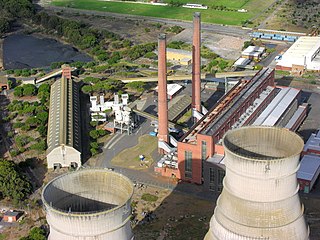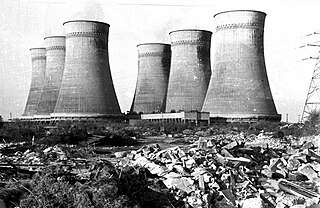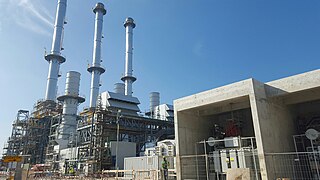
A power station, also referred to as a power plant and sometimes generating station or generating plant, is an industrial facility for the generation of electric power. Power stations are generally connected to an electrical grid.
The Manx Electricity Authority was a Statutory Board of the Isle of Man Government which generated and supplied electricity for the Isle of Man. In 2014 it became part of the Manx Utilities Authority when it was merged with the Isle of Man Water and Sewerage Authority.

Three distinct coal-fired power stations were built at Deptford on the south bank of the River Thames, the first of which is regarded as the first central high-voltage power station in the world.

Peterborough Power Station is a 360MW gas-fired power station at Eastern Industry, Fengate in the city of Peterborough, Cambridgeshire in the United Kingdom. It employs around forty people.

Little Barford Power Station is a gas-fired power station just north of the village of Little Barford in Bedfordshire, England. It lies just south of the A428 St Neots bypass and east of the Wyboston Leisure Park. The River Great Ouse runs alongside. It was formerly the site of two coal-fired power stations, now demolished.

Great Yarmouth Power Station is combined cycle gas turbine power station on South Denes Road in Great Yarmouth in Norfolk, England, with a maximum output of 420 MW electricity, opened in 2001. It is built on the site of an oil-fired power station, built in 1958 and closed and demolished in the 1990s. A coal-fired power station was built in Great Yarmouth in 1894 and operated until 1961.

Shoreham Power Station is a 420MWe combined cycle gas-fired power station in Southwick, West Sussex. It was built on the site of the Brighton B Power Station.

The Tilbury power stations were two thermal power stations on the north bank of the River Thames at Tilbury in Essex. The 360 MW dual coal- and oil-fired Tilbury A Power Station operated from 1956 until 1981 when it was mothballed, prior to demolition in 1999. The 1,428 MW Tilbury B Power Station operated between 1968 and 2013 and was fueled by coal, as well as co-firing with oil and, from 2011, biomass. Tilbury B was demolished in 2016–19. Since 2013 three other power stations have been proposed or constructed in Tilbury.

The Croydon power stations refers to a pair of demolished coal-fired power stations and to a gas-fired power station in the Purley Way area of Croydon, London.
The Jersey Electricity Company or Jersey Electricity is a public limited company, and the sole provider for electricity in Jersey. The JEC has two sites around the island: Queen's Road, St Helier, the site of two Rolls Royce Olympus gas turbines and La Collette Power Station where there are five Sulzer Diesel turbines, one Rolls Royce Olympus turbine, and three Parsons steam turbines.

Electricity sector in Hong Kong ranges from generation, transmission, distribution and sales of electricity covering Hong Kong. There are two main providers of electricity in Hong Kong.
Butibori Power Project is a coal-based thermal power plant located at Butibori near Nagpur in the Indian state of Maharashtra. The power plant is operated by the Reliance Power.

The main power supply for Shetland is provided by Lerwick Power Station, located in Gremista, 2 kilometres (1.2 mi) northwest of Lerwick town centre. This is the principal source of electrical energy for Shetland, however currently about 20 MWe is provided by the Sullom Voe Terminal power station which comprises 4 x 23 MWe Gas Turbines, the future of which is uncertain. Opened on 27 May 1953 the station is diesel-fuelled and generates a total of 66 MW of power.
Guernsey Electricity Limited (GE) is the sole commercial electricity supplier on the island of Guernsey. GE has been operating for over 100 years, moving from local generation of power from coal, and later oil, to investing in cables to connect into the grids in Jersey and France through the Channel Islands Electricity Grid.

Stornoway power station, also known as Battery Point Power Station, is an electrical generation facility in Stornoway, Scotland. It was commissioned in 1954 to supply power to the Western Isles and currently comprises eight Mirrlees Blackstone, medium speed, diesel generators with a combined output of 25.5MW. The station is owned and operated by Scottish and Southern Electricity Networks (SSEN) part of SSE plc. The Western Isles power network was originally operated independently of the Scottish mainland network.

The Delimara power station is located near Marsaxlokk in the southeast of Malta and is the newest power plant in Malta. It was put into operation in 1992 and redeveloped in the 2010s.
The Worcester Power Stations were a series of hydro-electric and coal-fired generating stations providing electricity to the City of Worcester.
Blackburn power stations are a series of electricity generating stations that have provided electric power to the town of Blackburn and the wider area from 1895 to the present. The first station in Jubilee Street, Blackburn began operating in 1895. A new larger station known as Blackburn East or Whitebirk power station was commissioned in 1921 and was rebuilt in stages over the period 1942 to 1955. Whitebirk station closed in 1976. The 60 MW Blackburn Mill Combined Cycle Gas Turbine (CCGT) power station has generated electricity since 2002. The Blackburn energy from waste (EfW) plant is currently (2020) being planned.
Machynlleth power stations were two small electricity generating stations in Machynlleth Powys. They provided electricity to the town and the surrounding rural district from 1938 until the 1970s. The A station was a combined diesel & hydro-electric plant and the B station was a diesel engine plant.
The Macclesfield group power stations are three relatively small electric power stations at Alderley Edge, Buxton, and Macclesfield, England. They supplied electricity to their respective towns from 1890s to the 1960s. The oil-engine stations were operated by a succession of private and public owners prior to the nationalisation of the British electricity industry in 1948. The power stations were redeveloped as a group in the 1950s as demand for electricity grew and old plant was replaced.













